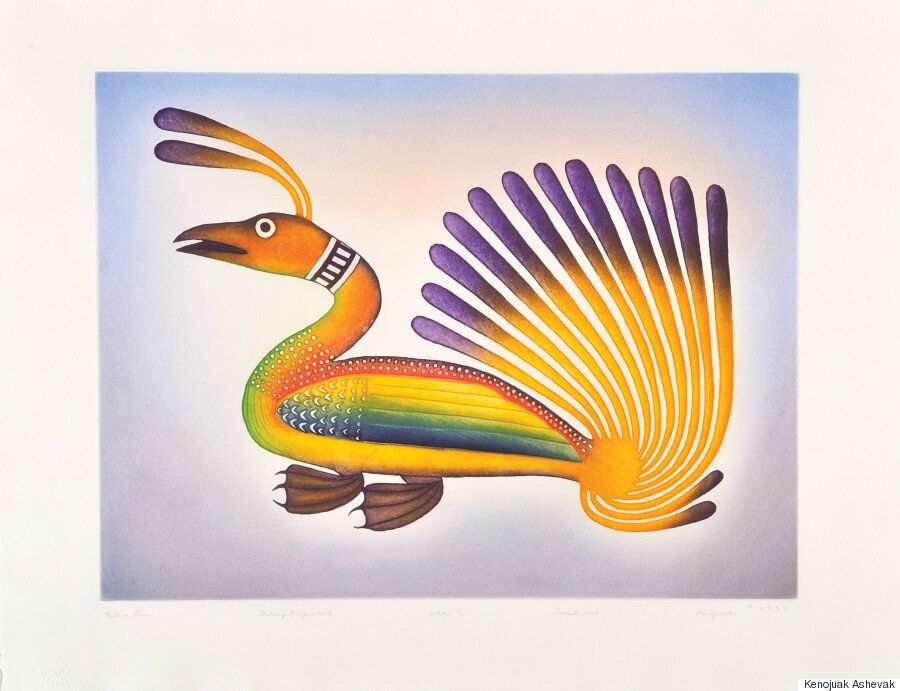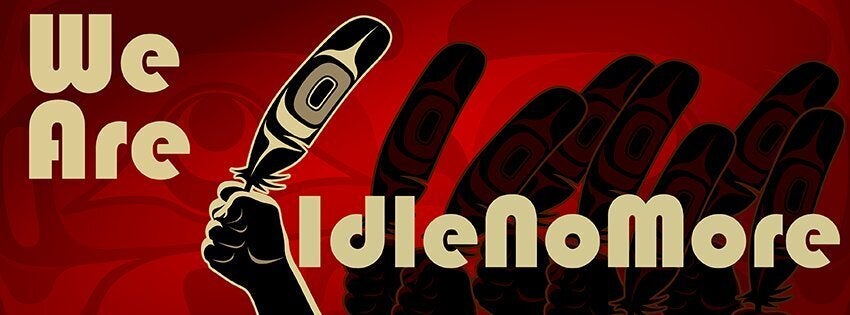EDITOR’S NOTE: This story was originally published in 2012, and has been updated since that time.
Dec. 10, 2012 was a day of protests that brought thousands of people into the streets across Canada for Idle No More Day of Action, as Indigenous people resisted federal legislation that had deep implications for their lands.
The laws passed, but Idle No More hasn’t faded away.
It has grown to take on other issues, like crowdfunding for First Nations housing, or pushing for an inquiry into missing and murdered Indigenous women (which is now happening).
HuffPost Canada marked the anniversary of the Idle No More Day of Action by featuring powerful works of art by Indigenous artists from across the country.
These prints, paintings and holograms reflect the cultures and traditions of Indigenous people. And they illustrate their struggles in poignant strokes.
Here are 15 dazzling works of Indigenous art from across the country:
Andy Everson — “Defender”

Andy Everson of the K’ómoks First Nation in B.C. has built a strong profile with spectacular prints that incorporate pop cultural elements. His piece "Defender" uses a stormtrooper helmet from "Star Wars" to reflect on the theme of ancestry, and the importance of standing up for one's community and environment.
A heron on the helmet represents the ‘Na̱mg̱is ancestor ‘Na̱mukustolis. He is believed to have come to Earth in the form of a bird and later transformed into the Nimpkish River in order to feed his people with fish.

Everson's "Transcendence" came about as he created a wood design for the B.C.-Canada Pavilion at the 2008 Summer Olympic Games in Beijing. The design, which also had a print version shown above, evokes the myth behind the white Kermode, or "Spirit Bear."
The Tsimshian people have a story in which the mythical Raven turned every ten black bears to white so that people would remember the Earth was previously covered in ice.

Daphne Odjig was born into the Wikwemikong First Nation in northern Ontario. One of Canada’s most prominent Indigenous artists, her works often mix aboriginal forms with Cubism and Surrealism.
Her “Infinite Cycle” depicts her first husband’s funeral. Family relations are represented with black forms, while whiter forms stand for guiding spirits.
Daphne Odjig — “Genocide No. 1”

Odjig here uses deep reds and curving forms to reflect the traumas that colonialism has inflicted upon Indigenous people.
Daphne Odjig — “The Indian in Transition”

“The Indian in Transition” is a mural that was commissioned by the Canadian Museum of Civilization. It reflects the history of Indigenous people from before contact with Europeans, through centuries of colonization. A mythic Thunderbird watches history unfold from above.
Kenojuak Ashevak — “Gulls and Ravens”

Inuk artist Kenojuak Ashevak was among Canada's most renowned artists. Born in Cape Dorset, Nunavut, she achieved international prominence thanks to a stunning series of prints and sculpture.
Her piece "Gulls and Ravens" used cut-out shapes of two of her favourite bird species on a piece of paper. They provide a contrast between dark and light, and negative and positive spaces, according to the National Gallery of Canada.

This bright piece uses etching and aquatint, a printing technique that provides the look of a watercolour painting. "Spirit of the Sun" depicts rounded lines that are characteristic of much of Ashevak's work, such as "The Enchanted Owl."

Ashevak also used etching and aquatint for this 2008 piece, which displays a loon with forms similar to the ones in "Spirit of the Sun."

Mary Longman of the Gordon First Nation in Saskatchewan is a mixed-media artist whose work demonstrates how pop culture and government documents have created a false notion of aboriginal identity.
"Hills Never Lie — Lebret Graveyard" is a holographic work that shows a Cree man, possibly influential activist Big Bear, standing in a graveyard in Fort Qu'Appelle, Sask. His picture transforms into a self-portrait of the artist, standing on the same site in a Hudson's Bay blanket, 125 years later.
Long ago, such blankets were given to chiefs in an effort to make them sign treaties. But oral history says such blankets were infected with smallpox in an effort to wipe out First Nations (Big Bear himself survived smallpox). Longman's self-portrait is a testament to the persistence of First Nations in the face of threats like disease and residential schools.

(Image courtesy of Mary Longman)
“Captivity Narratives” is a comment on a literary genre in which European women are captured by Indigenous people.
Earlier stories posited Indigenous people as savages by depicting them kidnapping women for ransom. Later narratives have taken on a romantic tone, in which women fall for eroticized captors and are thereafter rejected by their own communities.
Mary Longman — “100 Bill — Buffy Sainte-Marie and Elizabeth Mountbatten”

This holographic piece shows an image of Queen Elizabeth II on the $100 Canadian banknote turning into singer-songwriter Buffy Sainte-Marie.
Longman presents both of them as royalty: the Queen, presented with her birth name, is situated in front of Buckingham Palace, while Sainte-Marie is depicted before Saskatchewan's Qu'Appelle Valley. Their respective accomplishments are listed at right.
As Longman writes in an artist statement, "This work challenges common perspectives on greatness, and also questions the absence of female leaders and the way that leadership is defined in our country."

(Image courtesy of Aaron Paquette)
Artist. Author. Politician. Three words you can use to described Edmonton-based First Nation/Métis artist Aaron Paquette. He’s known for striking paintings that ruminate on human relationships with their natural surroundings.
His painting “We Are Not Your Property” comments on the perception of Indigenous women as objects, and not as people.
Aaron Paquette — “Metamorphase”

"Metamorphase" is a powerful work that shows a dark bird carrying a light in its talons. It's reminiscent of the story "Raven Steals the Light," in which the mythical bird brings luminescence to humanity.
As it happens, the Raven is a transformer figure. Could this be a phase in its metamorphosis?

(Image courtesy of Aaron Paquette)
“Night Walk” is an affecting work that reflects on the legacy of residential schools.
The painting shows an Indigenous person standing alone in the cold, with only the moon lighting the way.
Paquette’s website displays the painting with a lengthy description of the suffering that residential school has inflicted on generations of students. Then he reveals that he’s the “first generation of my family that wasn’t taken from my home. Imagine that.”
Aaron Paquette — “Equilibrium”

Paquette's "Equilibrium" considers the idea of balance, where we find it, and how we achieve it.
For him, it means, "to cease with doubts, but never with examination. To enjoy the show but to realize it is all a shadow play."
He does this through an image of a dark bird, a forest growing on its wings while its neck encircles the moon.


Also on HuffPost:
